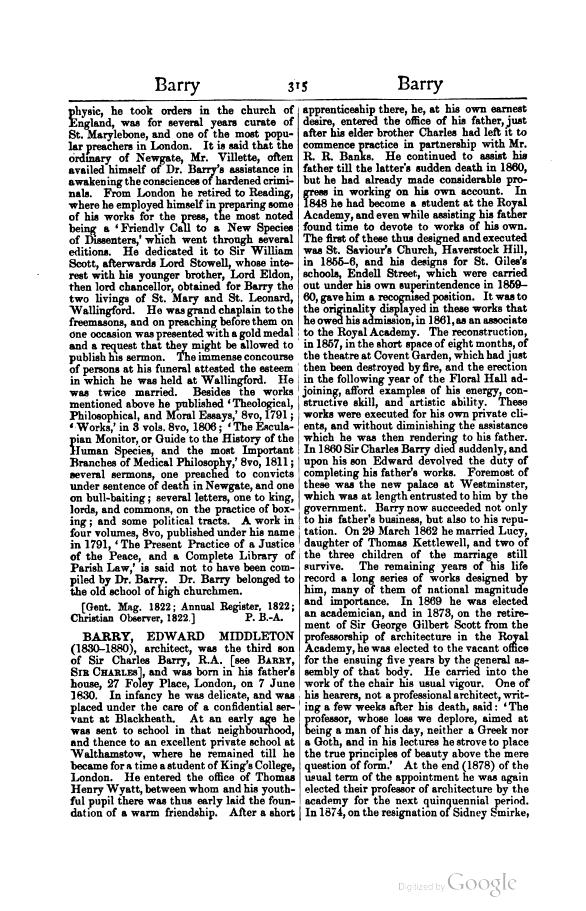physic, he took orders in the church of England, was for several years curate of St. Marylebone, and one of the most popular preachers in London. It is said that the ordinary of Newgate, Mr. Villette, often availed himself of Dr. Barry's assistance in awakening the consciences of hardened criminals. From London he retired to Reading, where he employed himself in preparing some of his works for the press, the most noted being a ‘Friendly Call to a New Species of Dissenters,’ which went through several editions. He dedicated it to Sir William Scott, afterwards Lord Stowell, whose interest with his younger brother, Lord Eldon, then lord chancellor, obtained for Barry the two livings of St. Mary and St. Leonard, Wallingford. He was grand chaplain to the freemasons, and on preaching before them on one occasion was presented with a gold medal and a request that they might be allowed to publish his sermon. The immense concourse of persons at his funeral attested the esteem in which he was held at Wallingford. He was twice married. Besides the works mentioned above he published ‘Theological, Philosophical, and Moral Essays,’ 8vo, 1791; ‘Works,’ in 3 vols. 8vo, 1806; ‘The Esculapian Monitor, or Guide to the History of the Human Species, and the most Important Branches of Medical Philosophy,’ 8vo, 1811; several sermons, one preached to convicts under sentence of death in Newgate, and one on bull-baiting; several letters, one to king, lords, and commons, on the practice of boxing; and some political tracts. A work in four volumes, 8vo, published under his name in 1791, ‘The Present Practice of a Justice of the Peace, and a Complete Library of Parish Law,’ is said not to have been compiled by Dr. Barry. Dr. Barry belonged to the old school of high churchmen.
[Gent. Mag. 1822; Annual Register, 1822; Christian Observer, 1822.]
BARRY, EDWARD MIDDLETON (1830–1880), architect, was the third son of Sir Charles Barry, R.A. [see Barry, Sir Charles], and was born in his father's house, 27 Foley Place, London, on 7 June 1830. In infancy he was delicate, and was placed under the care of a confidential servant at Blackheath. At an early age he was sent to school in that neighbourhood, and thence to an excellent private school at Walthamstow, where he remained till he became for a time a student of King's College, London. He entered the office of Thomas Henry Wyatt, between whom and his youthful pupil there was thus early laid the foundation of a warm friendship. After a short apprenticeship there, he, at his own earnest desire, entered the office of his father, just after his elder brother Charles had left it to commence practice in partnership with Mr. R. R. Banks. He continued to assist his father till the latter's sudden death in 1860, but he had already made considerable progress in working on his own account. In 1848 he had become a student at the Royal Academy, and even while assisting his father found time to devote to works of his own. The first of these thus designed and executed was St. Saviour's Church, Haverstock Hill, in 1855–6, and his designs for St. Giles's schools, Endell Street, which were carried out under his own superintendence in 1859–60, gave him a recognised position. It was to the originality displayed in these works that he owed his admission, in 1861, as an associate to the Royal Academy. The reconstruction, in 1857, in the short space of eight months, of the theatre at Covent Garden, which had just then been destroyed by fire, and the erection in the following year of the Floral Hall adjoining, afford examples of his energy, constructive skill, and artistic ability. These works were executed for his own private clients, and without diminishing the assistance which he was then rendering to his father. In 1860 Sir Charles Barry died suddenly, and upon his son Edward devolved the duty of completing his father's works. Foremost of these was the new palace at Westminster, which was at length entrusted to him by the government. Barry now succeeded not only to his father's business, but also to his reputation. On 29 March 1862 he married Lucy, daughter of Thomas Kettlewell, and two of the three children of the marriage still survive. The remaining years of his life record a long series of works designed by him, many of them of national magnitude and importance. In 1869 he was elected an academician, and in 1873, on the retirement of Sir George Gilbert Scott from the professorship of architecture in the Royal Academy, he was elected to the vacant office for the ensuing five years by the general assembly of that body. He carried into the work of the chair his usual vigour. One of his hearers, not a professional architect, writing a few weeks after his death, said: ‘The professor, whose loss we deplore, aimed at being a man of his day, neither a Greek nor a Goth, and in his lectures he strove to place the true principles of beauty above the mere question of form.’ At the end (1878) of the usual term of the appointment he was again elected their professor of architecture by the academy for the next quinquennial period. In 1874, on the resignation of Sidney Smirke,
